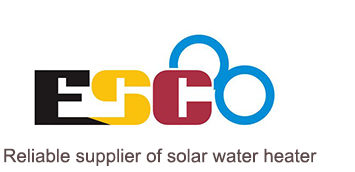Solar water heater hose (garden hose), which is generally a homemade solar water heater, can also produce hot water, DIY solar water heater can only do some solar energy test, cannot provide hot water heating such as swimming pool, pool heater needs to buy solar water heater, There is usually a heat collecting device placed on the roof, which transfers hot water through pipes, satisfies daily showers, wash dishes, and enjoys life. We offer a wide range of models of solar water heaters at affordable prices and good quality products.
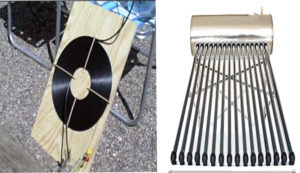
How to make your own solar water heater?
To make your own solar water heater, all you really need is a bit of black garden hose, and something onto which you can coil it up and hold it into position. You then connect it to your pool filter so that the filtered water passes through your homemade solar water heater before it goes back into the pool.
The idea is to warm up the filtered water as you filter it. If you aren’t using it with your filter, you’ll need some sort of water pump to push the water through your black garden tubing.
You can also connect this between your faucet and your pool to heat the water as you fill your pool. If you’re doing it that way, you don’t need to use a pump and rely on the force of the water coming from the faucet, of course.
I will say that you use up a lot more tubing than you would imagine. We made this last year so I can’t remember how much tubing we actually used, but I would take a guess at around 100m of tubing!
Our solar water heater product list
Stainless steel low pressure solar water heater Evacuated tube solar water heater

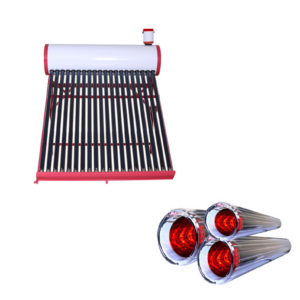
Glass Tubes Solar Water Heater Flat plate solar water heater
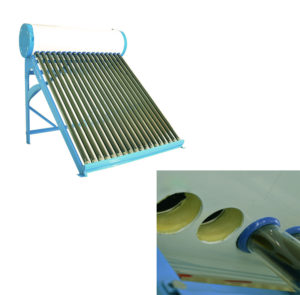
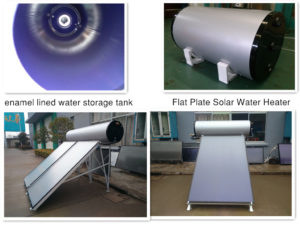
Electric storage water heater Heat Pipe Collector Solar Water Heater
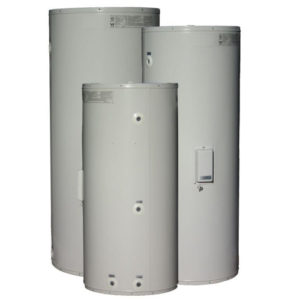
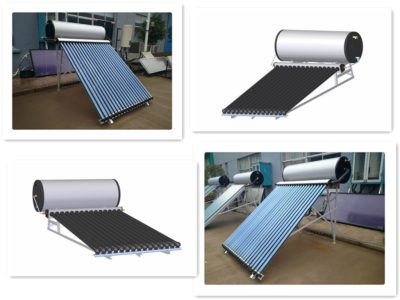
Split type solar water heating system porcelain enamel lined storage tank
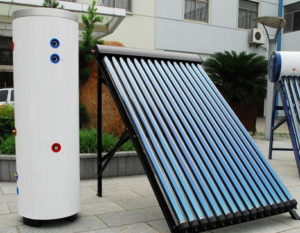
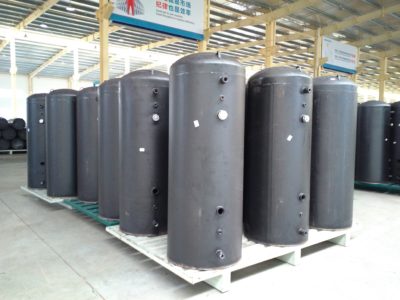
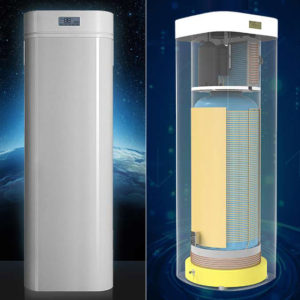
How does a homemade solar water heater work?
When the water begins to come out of the hose, it is pretty hot, but it will cool down a little as more cold water runs through it. You might think that it means that the homemade solar water heater isn’t working very well anymore, but if you compare the temperature of the water to the cooler water in your pool, you should notice that the water is still being heated quite a bit.
For the first time this year, we decided to leave up our above ground swimming pool as an experiment because it’s a hassle to take it down and clean and dry it, fold it, store it, and take it out to fill again! We’d heard about people leaving theirs up all winter successfully, and decided to try it out for ourselves.
It worked out wonderfully, and this past weekend my son and niece were already playing in the pool!
They would have been playing in it weeks ago if it hadn’t been for the cool weather we’ve been having this spring. Before they began to swim, I checked the temperature of the water in the pool, and it was under 80 degrees Fahrenheit.
I didn’t think to check the temperature of the water coming out of the heater until after it had been running for a while and was feeling much cooler again, but even then that water was above 95ºF.
It easily brought up the temperature of our small pool a couple of degrees after running a short time, and it made for more comfortable swimming for the kids.
How much does it cost to buy homemade solar water heater materials?
Buying all new parts for this solar water heating system might cost around $300 or $400, but there are many ways to modify the design to incorporate salvaged parts or for enhancing the system. For longevity and durability, the parts should be rated for UV exposure and high temperatures. Most plastic (PVC and polyethylene) will start to deform above 140°F, and a typical garden hose will not hold its shape much over 100°F.
The parts list includes recommended materials and temperature ratings. Use materials that can withstand temperatures up to 180°F, such as metal, CPVC, or polypropylene fittings, as well as high-temperature water hose material, such as EPDM rubber. The black-colored hose will assist in absorbing solar heat.
How to Make a Solar Water Heater?
Depending on the method of solar heating used, here is a list of some things you may need to have when using solar heating of water.
- Four 8-foot 2x4s
- Five 8-foot 1x4s
- 2 1/2″ deck screws
- 3/4″ roofing screws or galvanized sheet metal screws
- Two 2 x 8-foot corrugated metal roofing panels
- High-temperature, flat black spray paint
- One 100-foot, black EPDM rubber garden hose, 3/4″
- I.D. (inner diameter), rated for 200°F
- One hundred 8″ black plastic cable ties, UV-resistant, heat-stabilized, rated for over 200°F
- One 55-gallon barrel, black plastic, preferably with wide-mouth top
- Two 3/4″ NPT (National Pipe Thread) /GHT (garden hose thread) brass faucets, rated for 180°F
Teflon tape - Two 3/4″ polypropylene bulkhead fittings, rated for180°F
- Two 3/4″ brass garden hose-to-tubing adapters
- Two hose clamps
- One 36″ length foam pipe insulation
The first method of solar hot water heater homemade is as follows:
- Step 1: Using large loops, stretch a 100 foot long black garden hose out over the southern side of the roof.
- Step 2: Attach on end of the hose to your homes incoming cold water line.
- Step 3: Take the other end of the hose and attach it to the cold water intake of your water heater.
Your water will now be warm before it enters your water heater as the heat from the sun will be absorbed by the hose, thus warming the water.
Here is a youtube video guide on making hoses for solar water heaters.
Advantages of using solar water heaters in swimming pools
A long loop of 2-inch black PVC tubing that is a bypass into your pool’s water pump hose are the basics of a solar heating system for your pool. Many people spend over a thousand dollars to get a heater for their pool, but by putting in a solar system it’s possible you can spend about one fifth of that.
First, you need to be sure to get black PVC piping. White reflects sun and black has the opposite effect. Get yourself at least 200 feet of 2 inches black PVC pipe along with the following.
- a proportionate amount of 2-inch, black PVC elbow fittings
- some hose clamps
- PVC glue
- Primer
Now your ready to know how to use solar power to heat your pool.
- Find area of the pool that receives the most light.
- Determine loop and grid. Figure out where to lay the pipe. Keep in mind that the roof of a blacktop garage will run lots of heat.
- Run a continuous loop of the tubing from the pool to a series of parallel lines, interconnecting PVC tubing throughout the grid loop. Now you have a single loop grid collecting energy from the sun and using it’s energy to heat your pool.
Why should the solar water heater be placed on the roof?
There are basically two very similar methods. They both use the sun to preheat the water that is then fed into your regular water heater.
1) Tanks – This is essentially a black water tank on the roof. The dark color absorbs the sun’s rays, heating the water. The advantage of using a tank system is that the water held in the tank often has enough weight to allow the heated water to flow into your water heater as well as new, unheated water to flow into the water heater on roof tanks without additional pumping.
The obvious disadvantage is that such a heavy system could require reinforcement of the roof against the sheer weight of the system as well as against wind, as the tank enclosure tends to be a high profile construction.
2) Hoses – Using the same principle as the tank system, fresh water is pumped through dark-colored hoses arranged in a serpentine pattern on the roof. While eliminating or reducing the weight and wind issues of the tank system, the hose system has its own concerns.
While the tank system utilizes tanks in a protective enclosure, the hoses in a hose system are exposed to the elements and might not last as long as a tank system. The second issue is that without a great deal of water weight being concentrated in any one place, pumping is the only option to cycle fresh water into the system.
How to do solar water heater installation
- Figure out how much thermal panel you will need for the roof or where you are putting the system. On the average, figure you will need approximately 20 square feet for two residents. For more people add around 8 square feet each, although you may want to make it up to 14 feet if you live in a particularly cold region.
- Find out where you want to put the panel. On your roof is usually the best place as you can secure mountings to the rafters and may be convenient to run pipe to your hot water heater.
- Measure out where the mountings will be. Make sure you line them up with the thermal panel to be sure they match.
- Using a power drill, install the mounting with screws and brackets.
- Use sealant, such as caulk, to seal up any holes.
- Install rails onto mounts. Be sure they are fixed in place.
- Install thermal panel on rails insuring they are secure enough to withstand rain or poor weather.
- For the panel connection to the water pipe, you will have to install a roof boot. Do not place the boot over any rafters. The boot should be about 2 inches from the feed connection on your solar panel.
- Use flashing, and caulk if needed, to make the boot’s connection to the hole surrounding it watertight.
- Install roof boot number two about 2 inches from the absorber outlet of solar power.
- Attach compression unions to roof boot and use copper tubing to connect compression unions to feeds on the solar panel. Be sure to check that all connections will not leak.
- Run copper tubing from both feeds to the water heater.
- Turn off gas and drain all water from the water heater, then install coaxial fitting onto water heater.
- Making sure the connections are correct, which should be the feed line taking cool water out to the water panel and the return line being hot water in, connect the copper tubes to the fitting.
- Even if sealant or Teflon tape is needed, you need to make sure that there are no leaky connections.
- Use a stud finder to find the rafters and align mounts. Pre-drill with pilot bit to avoid splitting and make sure to keep mounts in a straight line using laser sight or chalk line.
- Use stainless steel lag bolts to attach mounts to the roof.
- Place metal flashings over the mounts and use 3/8′ stainless steel bolts to secure metal rails to the posts.
Related Searches: Flat plate solar water heater | Electric storage water heater | Air source water heater
Want to know more?(Solar Water Heater)
Email: [email protected]
WhatsApp:+86 157 2077 3477
Skype :+86 157 2077 3477
